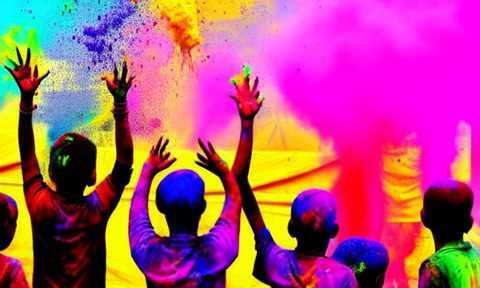Holi is a festival that brings people together from all walks of life, transcending cultural and religious barriers.
It is celebrated with great enthusiasm and joy in India and other parts of the world.
Writing an essay on Holi can be a great way to learn about the festival and its significance, while also practicing your writing skills.
Writing an essay on Holi Festival is one of the most frequently asked topic in schools so here we are providing an engaging, informative and readymade 10 liner, short (250-300 words) and a medium length essay of 500 words on this colorful festival.
10 Liner Essay on Holi Festival [100 Words]
1. Holi is a fun festival that happens in India.
2. It is also called the “Festival of Colors”.
3. Holi comes in the month of March when the flowers start to bloom.
4. People play with colorful powders and water on Holi.
5. On this day we dance, sing and have fun with our friends and family.
6. Holi is a time when we forget about our differences and come together.
7. We also eat yummy sweets and snacks on Holi.
8. Holi is a time for saying sorry and making new friends.
9. On the first day of Holi, we light bonfires and tell stories.
10. Holi is a happy festival that teaches us to love and be kind to everyone.
Holi Festival Essay for Junior School Students [Class 1-5]

250-300 Words Essay
Holi is a popular Hindu festival celebrated in India and other countries with great enthusiasm and joy.
It is also known as the “Festival of Colors” and marks the arrival of spring.
Holi is a time for people to come together and celebrate by throwing colored powders and water at each other, dancing, singing, and feasting.
The festival is usually celebrated in March and lasts for two days.
The first day is known as Holika Dahan, which is the night before Holi.
On this day, people light bonfires to symbolize the victory of good over evil.
The second day is the main day of the festival, and it is when people play with colors and water.
Holi is a time for people to forget their differences and come together as one community.
It is a time for forgiveness and letting go of past grievances.
The festival is celebrated by people of all ages, and children particularly enjoy the fun and excitement of playing with colors.
Children often wake up early on the day of Holi and gather with their friends to play with colors.
They chase each other with water guns, throw colored powder at each other, and dance to traditional music.
Many people also prepare delicious food and sweets, which they share with their neighbors and friends.
Holi is a festival that teaches us the importance of love, unity, and togetherness.
It is a time to celebrate diversity and appreciate the beauty of different cultures.
It is also a time to remember the importance of nature and the arrival of spring.
In conclusion, Holi is a vibrant and joyous festival that is loved by people all over the world.
It is a time to celebrate with family and friends, and to embrace the colors of life.
Holi reminds us of the importance of forgiveness, togetherness, and the beauty of diversity.
500 Words Essay
Holi, commonly known as the festival of colors, is a revered occasion celebrated with immense enthusiasm in India.
It holds great significance and is considered one of the most significant festivals of the country.
The festival usually occurs in March and is observed on the full moon day of the Hindu month of Phalguna.
The origin of Holi can be traced back to an ancient Indian legend that narrates the story of a demon king named Hiranyakashyap, who demanded that his subjects worship him alone.
His son Prahlad was a devotee of Lord Vishnu and refused to comply with his father’s orders.
The king became infuriated and made several attempts to kill Prahlad.
Finally, he asked his sister, Holika, who had the power to withstand fire, to sit with Prahlad in a burning pyre.
However, Lord Vishnu saved Prahlad, and Holika burned to ashes.
This event is celebrated as Holi, symbolizing the victory of good over evil.
Holi is celebrated differently across India.
In North India, people celebrate the festival by lighting a bonfire on the evening before the actual date of Holi, known as Holika Dahan, symbolizing the triumph of good over evil.
On the day of Holi, people play with colors and water.
They smear colored powder on each other’s faces, throw water balloons and sing and dance to lively music.
In some parts of India, such as Mathura and Vrindavan, the birthplace of Lord Krishna, Holi is celebrated with grandeur.
People here start celebrating the festival a week in advance.
They play with colors, sing devotional songs, and perform traditional dances.
The celebrations culminate in the ‘Lathmar Holi,’ where women beat men with sticks, symbolizing the playful banter between Lord Krishna and his consort Radha.
Holi is not just a festival of colors but holds a deeper cultural and social significance.
The festival promotes unity and brings people together, setting aside their differences to celebrate together.
Holi is a celebration of love, promoting brotherhood and harmony among people of different religions, castes, and genders.
It is also an opportunity to forgive and forget past grievances and start afresh.
The popularity of Holi has extended beyond the borders of India, and today it is celebrated by people of various nationalities and cultures worldwide.
While Holi is a time of joy and happiness, it is crucial to celebrate the festival responsibly.
The colors used during the festival should be eco-friendly and safe, and people should respect each other’s boundaries while playing.
Holi should not be an excuse to indulge in inappropriate behavior or violence.
In conclusion, Holi is an exuberant and vivacious festival that celebrates the spirit of love, unity, and brotherhood.
It is a time when people come together, forget their differences, and promote peace and harmony.
Holi is a festival of colors, but it is also a celebration of life and happiness.
As we commemorate Holi, let us recall the values it represents and strive to create a world that is more inclusive, harmonious, and peaceful.
Essay on Holi in English for Senior School Students [Class 6-10]
Holi Festival: A Colorful Celebration of Love and Joy
Holi is one of the most popular festivals in India.
It is a festival of colors, happiness, and love.
People of all ages, young and old, celebrate this festival with great enthusiasm and excitement.
This festival is usually celebrated in the month of March, which marks the end of winter and the beginning of spring.
It is a two-day festival that is full of fun and joy.
What is Holi Festival?
Holi is a festival that is celebrated all over India.
It is a festival of colors and joy.
People celebrate this festival by throwing colored powders, water, and flowers on each other.
This festival is also known as the festival of love, as it brings people together and spreads love and happiness.
Holi is celebrated by people of all ages, from children to adults.
Why do we Celebrate Holi?
There are many stories and myths associated with the celebration of Holi.
One of the most popular stories is about Prahlad, a young prince who was a devotee of Lord Vishnu.
His father, the demon king Hiranyakashipu, did not like his son’s devotion to Lord Vishnu and wanted him to worship him instead.
But Prahlad refused to do so and continued to worship Lord Vishnu.
Hiranyakashipu became angry and decided to kill his son.
He asked his sister, Holika, who had a special power to withstand fire, to sit with Prahlad in a fire.
But Lord Vishnu saved Prahlad, and Holika was burnt in the fire.
This is why people light bonfires on the night before Holi, which is known as Holika Dahan, to celebrate the victory of good over evil.
Another popular story associated with Holi is the love story of Radha and Krishna.
Krishna, who was known for his mischievous nature, used to play pranks on Radha and her friends.
He used to throw colored water and powders on them, and they would retaliate by doing the same.
This playful tradition of throwing colors on each other became a part of the Holi celebrations.
How is Holi Celebrated?
Holi is a two-day festival that is celebrated in many ways.
On the first day, people light bonfires in the evening to celebrate Holika Dahan.
They throw grains, coconuts, and other offerings into the fire to ward off evil spirits.
On the second day, people wake up early in the morning and apply colors to each other.
They use colored powders, water, and flowers to play Holi.
People also wear new clothes and traditional Indian dresses like sarees, salwar kameez, and kurta pajamas.
They dance to traditional Holi songs and enjoy traditional Holi sweets like gujiya, mathri, and thandai.
Holi Safety Tips
While Holi is a fun and joyous festival, it is important to celebrate it safely. Here are some safety tips to keep in mind:
Use natural colors: Avoid using synthetic colors, as they can be harmful to the skin and eyes. Instead, use natural colors made from flowers and vegetables.
Protect your skin and eyes: Apply a layer of oil or lotion on your skin before playing Holi to protect it from the colors. Wear sunglasses to protect your eyes from the colors.
Stay hydrated: Drink plenty of water before and after playing Holi to stay hydrated.
Play in a safe environment: Play Holi in a safe environment, away from busy roads and traffic.
Conclusion
Holi is a festival of love and joy that brings people together.
It is a celebration of the victory of good over evil and the arrival of spring.
People of all ages, young and old, celebrate this festival with great enthusiasm and excitement.
The colorful celebration of Holi is a unique experience that is enjoyed by everyone.
The festival is not just about throwing colors on each other but also about spreading love, forgiveness, and friendship.
It is an occasion to forget past grievances and embrace new beginnings.
As we celebrate this festival, let us remember to do so safely, and with respect for each other and the environment.
Happy Holi!




